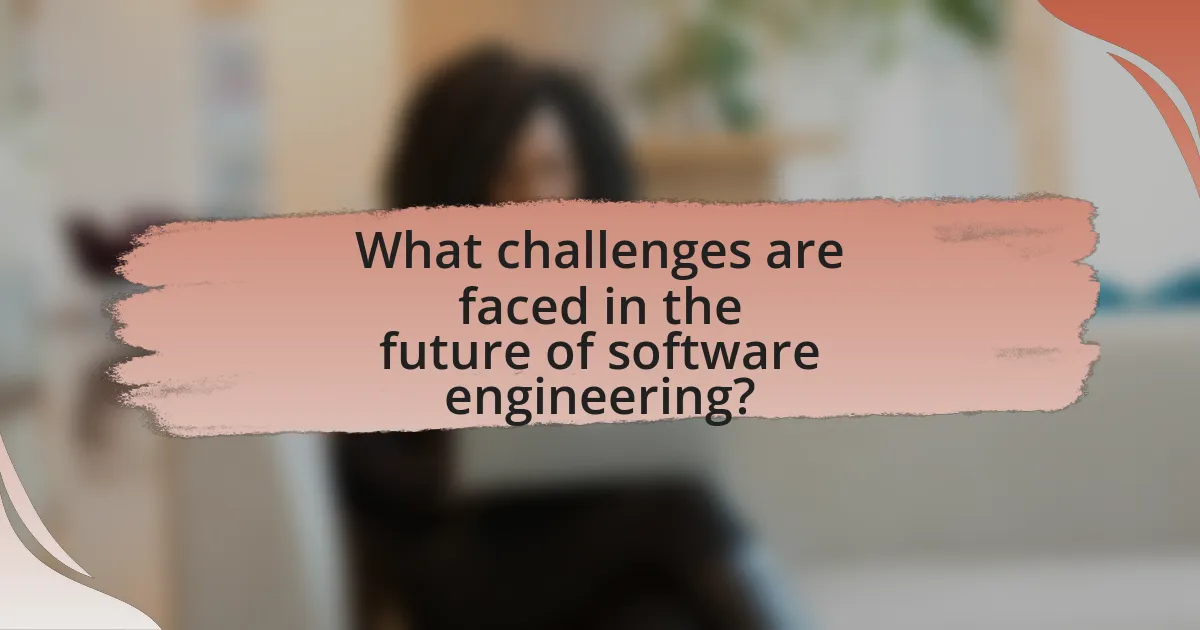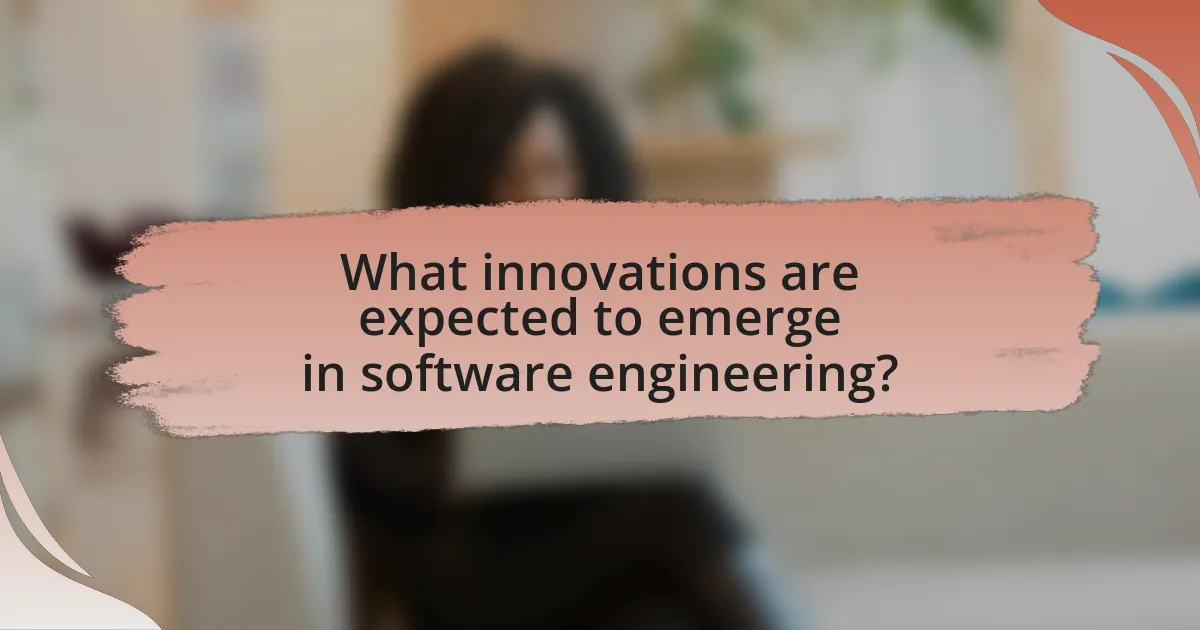The article focuses on the future of software engineering, highlighting key trends such as the rise of artificial intelligence, the adoption of cloud computing, and the integration of DevOps practices. It discusses how AI is transforming software development through automation and predictive analytics, while cloud computing enhances scalability and flexibility in application deployment. Additionally, the article examines the evolution of agile methodologies, the challenges posed by increasing system complexity, and the growing demand for skilled software engineers equipped with essential skills in AI, cloud computing, and cybersecurity. It also addresses innovations like low-code/no-code platforms and advancements in DevOps practices, emphasizing the importance of continuous learning and adaptation in the rapidly changing software landscape.

What are the key trends shaping the future of software engineering?
Key trends shaping the future of software engineering include the rise of artificial intelligence, increased adoption of cloud computing, and the emphasis on DevOps practices. Artificial intelligence is transforming software development by automating code generation and enhancing testing processes, as evidenced by tools like GitHub Copilot, which uses machine learning to assist developers. Cloud computing is facilitating scalable and flexible software solutions, with a report from Gartner indicating that by 2025, 85% of organizations will be cloud-first, impacting how applications are built and deployed. Additionally, the integration of DevOps practices is streamlining collaboration between development and operations teams, leading to faster delivery cycles and improved software quality, supported by the 2021 State of DevOps Report, which shows that high-performing teams deploy 200 times more frequently than low performers.
How is artificial intelligence influencing software development?
Artificial intelligence is significantly influencing software development by automating repetitive tasks, enhancing code quality, and enabling predictive analytics. Automation tools powered by AI, such as GitHub Copilot, assist developers in writing code more efficiently by suggesting code snippets and reducing the time spent on mundane tasks. Additionally, AI-driven testing frameworks improve code quality by identifying bugs and vulnerabilities early in the development process, leading to more robust software. Predictive analytics, facilitated by machine learning algorithms, allow teams to forecast project timelines and resource needs more accurately, optimizing project management. These advancements demonstrate that AI is reshaping the software development landscape, making it more efficient and reliable.
What specific AI technologies are being integrated into software engineering?
Specific AI technologies being integrated into software engineering include machine learning, natural language processing, and automated code generation tools. Machine learning algorithms enhance predictive analytics for software performance and bug detection, while natural language processing facilitates better communication between developers and non-technical stakeholders through tools like chatbots and documentation generators. Automated code generation tools, such as GitHub Copilot, leverage AI to assist developers in writing code more efficiently by suggesting code snippets based on context. These technologies are transforming software engineering practices by increasing productivity and improving code quality.
How does AI improve efficiency and productivity in software projects?
AI improves efficiency and productivity in software projects by automating repetitive tasks and enhancing decision-making processes. Automation through AI tools reduces the time developers spend on mundane activities such as code reviews, testing, and bug fixing, allowing them to focus on more complex and creative aspects of software development. For instance, AI-driven code analysis tools can identify potential issues and suggest optimizations, which accelerates the development cycle. Additionally, AI can analyze vast amounts of data to provide insights that inform project management decisions, leading to better resource allocation and risk management. According to a report by McKinsey, organizations that implement AI in their software development processes can achieve productivity gains of 20-30%.
What role does cloud computing play in the evolution of software engineering?
Cloud computing significantly transforms software engineering by enabling scalable, flexible, and cost-effective development environments. It allows developers to access resources on-demand, facilitating rapid deployment and continuous integration/continuous deployment (CI/CD) practices. According to a 2021 report by Gartner, 85% of organizations will adopt a cloud-first principle by 2025, underscoring the shift towards cloud-based solutions in software development. This transition enhances collaboration among distributed teams and accelerates innovation cycles, as developers can leverage cloud services for testing, storage, and computing power without the need for extensive on-premises infrastructure.
How does cloud infrastructure impact software deployment and scalability?
Cloud infrastructure significantly enhances software deployment and scalability by providing on-demand resources and flexible environments. This allows developers to deploy applications quickly without the need for extensive hardware investments or setup time. For instance, cloud platforms like AWS and Azure enable automatic scaling, which adjusts resources based on real-time demand, ensuring optimal performance and cost efficiency. According to a report by Gartner, organizations leveraging cloud infrastructure can reduce deployment times by up to 75%, demonstrating the efficiency and agility that cloud solutions offer in software engineering.
What are the advantages of cloud-native development practices?
Cloud-native development practices offer several advantages, including enhanced scalability, improved resilience, and faster time-to-market. These practices enable applications to be built and deployed in a way that leverages cloud environments effectively, allowing for automatic scaling based on demand. For instance, a study by the Cloud Native Computing Foundation found that organizations adopting cloud-native technologies can achieve up to 5 times faster deployment frequency compared to traditional methods. Additionally, cloud-native architectures, such as microservices, enhance resilience by isolating failures, which minimizes the impact on the overall system. This approach leads to improved uptime and user experience, reinforcing the benefits of adopting cloud-native development practices.
How are agile methodologies evolving in software engineering?
Agile methodologies are evolving in software engineering by increasingly integrating DevOps practices and automation tools to enhance collaboration and efficiency. This evolution is characterized by a shift towards continuous delivery and deployment, allowing teams to release software updates more frequently and reliably. According to the 2022 State of DevOps Report, organizations that adopt DevOps practices experience 46 times more frequent code deployments and 440 times faster recovery from failures, demonstrating the tangible benefits of this integration. Additionally, the rise of remote work has led to the adoption of virtual collaboration tools, further transforming agile practices to accommodate distributed teams.
What new agile frameworks are emerging in the industry?
New agile frameworks emerging in the industry include Scrumban, which combines Scrum and Kanban principles to enhance flexibility and efficiency, and Agile Scaling Framework (ASF), designed for larger organizations to implement agile practices at scale. Scrumban allows teams to visualize work and manage flow while maintaining the iterative nature of Scrum. ASF provides a structured approach for scaling agile across multiple teams, ensuring alignment and collaboration. These frameworks are gaining traction as organizations seek to adapt agile methodologies to their specific needs and complexities.
How do these frameworks enhance team collaboration and project outcomes?
Frameworks enhance team collaboration and project outcomes by providing structured methodologies that streamline communication and task management. These frameworks, such as Agile and Scrum, facilitate regular check-ins and feedback loops, which improve transparency and accountability among team members. For instance, Agile methodologies have been shown to increase project success rates by up to 28% due to their iterative approach, allowing teams to adapt quickly to changes and align their efforts with project goals. Additionally, the use of collaborative tools integrated within these frameworks fosters a shared understanding of project objectives, leading to more efficient workflows and higher quality deliverables.

What challenges are faced in the future of software engineering?
The future of software engineering faces several significant challenges, including the rapid pace of technological change, increasing complexity of systems, and the need for enhanced security measures. As technology evolves, software engineers must continuously adapt to new programming languages, frameworks, and tools, which can lead to skill gaps and increased training demands. Additionally, the complexity of integrating various systems and ensuring interoperability poses a challenge, as software becomes more interconnected. Furthermore, with the rise of cyber threats, engineers must prioritize security in their development processes, necessitating a shift towards secure coding practices and regular security assessments. These challenges are compounded by the growing demand for software solutions across industries, requiring engineers to deliver high-quality products under tight deadlines.
How does the increasing complexity of software systems affect development?
The increasing complexity of software systems significantly affects development by introducing challenges in management, integration, and maintenance. As systems grow more intricate, developers face difficulties in understanding and coordinating various components, which can lead to increased errors and longer development cycles. For instance, a study by the Standish Group found that complex projects are 2.5 times more likely to fail than simpler ones, highlighting the risks associated with complexity. Additionally, the need for more sophisticated tools and methodologies, such as Agile and DevOps, becomes essential to manage this complexity effectively, as they promote iterative development and continuous integration, which can mitigate some of the challenges posed by intricate systems.
What strategies can be employed to manage software complexity?
To manage software complexity, strategies such as modularization, abstraction, and the use of design patterns can be employed. Modularization involves breaking down software into smaller, manageable components, which simplifies development and maintenance. Abstraction allows developers to focus on high-level functionalities without getting bogged down by intricate details, thereby reducing cognitive load. The application of design patterns provides proven solutions to common problems, promoting code reusability and maintainability. These strategies are supported by industry practices, such as Agile methodologies, which emphasize iterative development and continuous integration, further aiding in managing complexity effectively.
How does complexity impact software maintenance and updates?
Complexity significantly impacts software maintenance and updates by increasing the difficulty of understanding, modifying, and testing the software. As software systems grow in complexity, they often involve more interdependent components, which can lead to a higher likelihood of bugs and integration issues during updates. Research indicates that complex systems can require up to 50% more time for maintenance tasks compared to simpler systems, as developers must navigate intricate codebases and dependencies. Additionally, the presence of complexity can hinder the implementation of new features, as changes in one part of the system may inadvertently affect other areas, leading to potential regressions. Thus, managing complexity is crucial for efficient software maintenance and timely updates.
What security concerns are becoming more prevalent in software engineering?
Security concerns becoming more prevalent in software engineering include vulnerabilities related to cloud security, supply chain attacks, and the rise of artificial intelligence-driven threats. Cloud security issues arise as more organizations migrate to cloud environments, exposing sensitive data to potential breaches; for instance, a 2021 report by McAfee indicated that 83% of organizations experienced a cloud security incident. Supply chain attacks, such as the SolarWinds breach, highlight the risks associated with third-party software dependencies, emphasizing the need for rigorous vetting processes. Additionally, the integration of AI in software development introduces new vulnerabilities, as adversaries can exploit machine learning models, leading to data poisoning or adversarial attacks. These trends underscore the necessity for enhanced security measures and proactive risk management in software engineering.
How can developers mitigate risks associated with software vulnerabilities?
Developers can mitigate risks associated with software vulnerabilities by implementing secure coding practices, conducting regular security audits, and utilizing automated tools for vulnerability scanning. Secure coding practices, such as input validation and proper error handling, reduce the likelihood of introducing vulnerabilities during development. Regular security audits help identify and address potential weaknesses in the software before they can be exploited. Automated tools, like static and dynamic analysis tools, can efficiently detect vulnerabilities in code, allowing developers to remediate issues promptly. According to the 2021 State of Software Security report by Veracode, organizations that adopt these practices see a 50% reduction in vulnerabilities over time, demonstrating the effectiveness of proactive security measures.
What best practices should be followed for secure coding?
Best practices for secure coding include input validation, proper error handling, and the principle of least privilege. Input validation ensures that only acceptable data is processed, reducing the risk of injection attacks; for example, using whitelisting techniques can prevent malicious input. Proper error handling prevents the disclosure of sensitive information through error messages, which can be exploited by attackers. The principle of least privilege restricts user permissions to the minimum necessary, thereby limiting potential damage from compromised accounts. According to the OWASP Top Ten, following these practices significantly reduces vulnerabilities in software applications.
How is the demand for skilled software engineers changing?
The demand for skilled software engineers is increasing significantly due to the rapid digital transformation across industries. According to the U.S. Bureau of Labor Statistics, employment for software developers is projected to grow by 22% from 2020 to 2030, much faster than the average for all occupations. This surge is driven by the growing reliance on technology, the expansion of cloud computing, and the rise of artificial intelligence and machine learning applications. As businesses seek to innovate and improve efficiency, the need for skilled software engineers continues to rise, reflecting a robust job market in this field.
What skills are becoming essential for future software engineers?
Future software engineers must develop skills in artificial intelligence, cloud computing, and cybersecurity. As technology evolves, proficiency in AI enables engineers to create smarter applications, while cloud computing skills facilitate scalable solutions. Cybersecurity expertise is increasingly vital due to the rising number of cyber threats, with a report from Cybersecurity Ventures predicting that global cybercrime costs will reach $10.5 trillion annually by 2025. These skills are essential for adapting to the dynamic landscape of software engineering.
How can educational institutions adapt to meet industry needs?
Educational institutions can adapt to meet industry needs by integrating real-world projects into their curricula and collaborating with industry partners. This approach ensures that students gain practical experience and relevant skills that align with current market demands. For instance, a study by the National Center for Education Statistics indicates that programs incorporating internships and co-op experiences significantly enhance employability, with 70% of employers preferring candidates with such backgrounds. Additionally, institutions can regularly update their course offerings based on industry feedback, ensuring that the skills taught remain relevant and in demand.

What innovations are expected to emerge in software engineering?
Innovations expected to emerge in software engineering include advancements in artificial intelligence, low-code/no-code development platforms, and enhanced DevOps practices. Artificial intelligence is anticipated to automate coding tasks, improve debugging processes, and enable predictive analytics for software performance, as evidenced by the increasing integration of AI tools in development environments. Low-code and no-code platforms are projected to democratize software development, allowing non-technical users to create applications, which is supported by the rapid growth of these platforms, with the global low-code development market expected to reach $187 billion by 2030. Additionally, enhanced DevOps practices, including continuous integration and continuous deployment (CI/CD), are likely to streamline workflows and improve collaboration between development and operations teams, as organizations increasingly adopt agile methodologies to accelerate software delivery.
How will low-code and no-code platforms impact software development?
Low-code and no-code platforms will significantly democratize software development by enabling non-technical users to create applications without extensive programming knowledge. This shift allows businesses to accelerate their digital transformation efforts, as these platforms can reduce development time by up to 70%, according to a report by Forrester Research. Furthermore, the increased accessibility of these tools can lead to a surge in innovation, as more individuals can contribute ideas and solutions, ultimately fostering a more agile and responsive development environment.
What are the benefits and limitations of using low-code solutions?
Low-code solutions offer rapid application development and accessibility for non-technical users, enabling organizations to accelerate digital transformation. These platforms reduce the need for extensive coding knowledge, allowing business users to create applications quickly, which can lead to faster time-to-market and increased innovation. According to a report by Gartner, low-code development is expected to account for over 65% of all application development by 2024, highlighting its growing significance in the software engineering landscape.
However, limitations exist, including potential scalability issues and security concerns. Low-code platforms may not support complex applications as effectively as traditional coding, leading to performance bottlenecks. Additionally, reliance on third-party platforms can introduce vulnerabilities, as seen in various security breaches reported in low-code environments. Thus, while low-code solutions provide significant benefits in speed and accessibility, they also present challenges that organizations must carefully consider.
How do these platforms democratize software development?
These platforms democratize software development by providing accessible tools and resources that enable individuals without formal programming backgrounds to create software. For instance, low-code and no-code platforms allow users to build applications through visual interfaces and pre-built components, significantly lowering the barrier to entry. According to a report by Gartner, by 2024, low-code application development will account for more than 65% of all application development activity, illustrating the growing trend of empowering non-developers. This shift not only accelerates innovation but also diversifies the talent pool in software development, fostering a more inclusive environment.
What advancements in DevOps practices are anticipated?
Anticipated advancements in DevOps practices include increased automation, enhanced collaboration through AI-driven tools, and a stronger focus on security integration. Automation is expected to streamline workflows, reducing manual tasks and accelerating deployment times, as evidenced by the growing adoption of CI/CD pipelines, which have shown to improve release frequency by up to 200%. AI-driven tools will facilitate better collaboration among teams by providing insights and predictive analytics, thereby enhancing decision-making processes. Additionally, the integration of security practices, known as DevSecOps, is becoming essential, with studies indicating that organizations implementing these practices can reduce vulnerabilities by 50% or more.
How will automation reshape the DevOps landscape?
Automation will significantly reshape the DevOps landscape by enhancing efficiency, reducing human error, and accelerating the software delivery process. With the integration of automation tools, tasks such as code integration, testing, and deployment can be performed with minimal manual intervention, leading to faster release cycles. For instance, a report by Puppet in 2021 indicated that organizations implementing automation in their DevOps practices experienced a 50% reduction in deployment failures and a 60% decrease in recovery time from failures. This shift not only streamlines workflows but also allows teams to focus on higher-value tasks, ultimately driving innovation and improving collaboration across development and operations teams.
What tools are leading the way in DevOps innovation?
Leading tools in DevOps innovation include Docker, Kubernetes, Jenkins, and Git. Docker revolutionizes application deployment through containerization, allowing for consistent environments across development and production. Kubernetes enhances container orchestration, enabling automated deployment, scaling, and management of containerized applications. Jenkins serves as a widely adopted continuous integration and continuous delivery (CI/CD) tool, facilitating automated testing and deployment processes. Git, as a version control system, supports collaborative development and code management, essential for agile practices. These tools are integral to streamlining workflows and enhancing collaboration in software engineering, reflecting the ongoing trends in DevOps innovation.
How is the integration of IoT influencing software engineering?
The integration of IoT is significantly influencing software engineering by necessitating the development of more scalable, secure, and efficient software architectures. As IoT devices proliferate, software engineers must design systems that can handle vast amounts of data generated by these devices, leading to the adoption of cloud computing and edge computing solutions. For instance, a report by Gartner indicates that by 2025, there will be over 75 billion connected IoT devices, which underscores the need for robust software frameworks capable of managing this scale. Additionally, the focus on security has intensified, as IoT systems are often vulnerable to cyber threats, prompting engineers to implement advanced security protocols and practices. This shift towards IoT-centric software engineering is reshaping development methodologies, emphasizing agile practices and continuous integration to accommodate rapid changes in technology and user requirements.
What challenges arise from developing software for IoT devices?
Developing software for IoT devices presents several challenges, including security vulnerabilities, interoperability issues, and resource constraints. Security vulnerabilities arise because IoT devices often lack robust security measures, making them susceptible to cyberattacks; a report by the Internet of Things Security Foundation indicates that 70% of IoT devices are vulnerable to attacks. Interoperability issues occur due to the diverse range of protocols and standards used by different devices, complicating communication and integration; according to a study by McKinsey, this lack of standardization can hinder the scalability of IoT solutions. Resource constraints are significant as many IoT devices have limited processing power and memory, which restricts the complexity of software that can be deployed; research from Gartner shows that 75% of IoT projects fail due to inadequate resources.
How can software engineers ensure interoperability among IoT systems?
Software engineers can ensure interoperability among IoT systems by adopting standardized communication protocols and data formats. Utilizing protocols such as MQTT, CoAP, and HTTP enables devices from different manufacturers to communicate effectively. Additionally, implementing data formats like JSON and XML facilitates seamless data exchange. Research indicates that adherence to these standards significantly reduces integration challenges, as evidenced by the widespread adoption of MQTT in various IoT applications, which has improved device compatibility and communication efficiency across diverse platforms.
What are the best practices for adapting to the future of software engineering?
The best practices for adapting to the future of software engineering include embracing agile methodologies, investing in continuous learning, and leveraging automation tools. Agile methodologies, such as Scrum and Kanban, promote flexibility and responsiveness to change, which is essential in a rapidly evolving tech landscape. Continuous learning is crucial as technology advances; software engineers should engage in regular training and upskilling to stay relevant. Additionally, automation tools enhance efficiency by streamlining repetitive tasks, allowing engineers to focus on more complex problem-solving. These practices are supported by industry trends indicating that organizations adopting agile frameworks and investing in employee development see improved project outcomes and higher employee satisfaction.
How can teams stay updated with emerging technologies and trends?
Teams can stay updated with emerging technologies and trends by actively engaging in continuous learning and leveraging various resources. Regularly attending industry conferences, webinars, and workshops allows teams to gain insights from experts and network with peers. Subscribing to reputable technology journals and online platforms, such as IEEE Xplore and TechCrunch, provides access to the latest research and news. Additionally, participating in online forums and communities, like GitHub and Stack Overflow, fosters collaboration and knowledge sharing. According to a 2021 report by the World Economic Forum, 94% of business leaders believe that continuous learning is essential for adapting to technological changes, highlighting the importance of these strategies for teams.
What strategies can be implemented for continuous learning and improvement?
Implementing strategies for continuous learning and improvement in software engineering involves adopting practices such as regular code reviews, pair programming, and ongoing education through workshops and online courses. Regular code reviews enhance code quality and facilitate knowledge sharing among team members, while pair programming fosters collaboration and immediate feedback, leading to skill enhancement. Additionally, engaging in ongoing education, such as attending industry conferences or enrolling in relevant online courses, ensures that software engineers stay updated with the latest technologies and methodologies. According to the 2021 State of DevOps Report, organizations that prioritize continuous learning and improvement achieve 2.5 times more software deployment frequency and 1.5 times lower change failure rates, demonstrating the effectiveness of these strategies in enhancing performance and productivity.

Leave a Reply